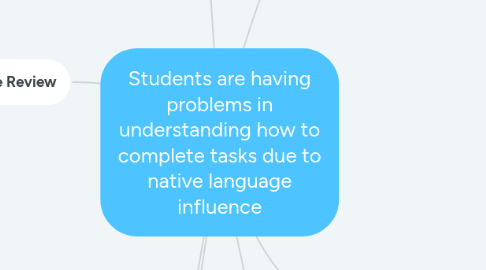
1. Instructional Strategies
2. Action Research
2.1. Practical-deliberate
2.2. Critical-emancipatory
2.3. Scientific-technical
3. Literature Review
3.1. Modelling
3.1.1. A teaching, instructional strategy that allows students to learn by observing (to demonstrate new concepts or approach to students)
3.1.1.1. To improve contextual understanding
3.1.1.1.1. Model when instructing students what are the steps they should do to complete the tasks given
3.1.1.1.2. Model for students to understand how the new concept works
3.1.1.2. To reduce student errors
3.1.1.2.1. Model when teaching students how to solve a problem
3.1.1.3. To improve contextual understanding
3.1.2. Task and performance modeling
3.1.2.1. Teacher demonstrates a task students will be expected to do on their own.
3.1.2.1.1. Science experiments
3.1.2.1.2. Foreign language communication
3.1.2.1.3. Solving Math equations
3.1.3. Metacognitive modeling
3.1.3.1. Teacher goes through multiple steps to solve a problem.
3.1.3.1.1. Going through multiple steps to solve Math problems
3.1.3.1.2. Reading class- rhetorical questions and expected answers
3.1.4. Modeling provides an accurate visual representations of knowledge that is needed when solving problems in some particular domain (Salisu & Ransom, 2014)
3.1.4.1. Modeling makes the process of understanding a domain of knowledge easier because it is a visual expression of the topic (Salisu & Ransom, 2014)
3.1.4.1.1. models work as translators of “forms of perceived reality (Arca et al, 1984)
3.1.5. Modelling as a scaffolding technique
3.1.5.1. English learners
3.1.5.1.1. Scaffolding
3.2. Learning
3.3. Teaching strategies
3.3.1. Visualisation
3.4. Demonstration
3.4.1. Use of demonstrations help students to better understand the subject (Basheer, 2017)
3.4.2. Demonstration sessions were found to promote thinking skills and to enable students to think more creatively (Basheer, 2017)
3.4.3. the terms demonstration and modeling are functionally equivalent, with demonstration being the more common sense term, while modeling is derived more from research in learning, primarily by Albert Bandura and Social Learning Theory.
3.5. Learning Theories
3.5.1. Behaviourism
3.5.1.1. Social Learning theory
3.5.1.1.1. Observational learning
3.5.1.2. Direct instructions
3.5.1.2.1. Step-by-step teaching
3.5.1.3. Programmed Instructions
3.5.2. Cognitivism
3.5.2.1. Cognitive Development
3.5.2.1.1. Piaget’s
3.5.2.2. Conditions of Learning
3.5.2.2.1. Intellectual
3.5.2.2.2. Cognitive strategies
3.5.2.2.3. Verbal information
3.5.2.2.4. Motor skills
3.5.2.2.5. Attitudes
3.6. Second language acquisition
4. Subjects
4.1. Mathematics
4.2. English
5. Objective
5.1. To improve understanding of students in completing tasks through modelling
5.1.1. Question
5.1.1.1. Would modelling improve semantics understanding of the students in successfully completing tasks?
5.1.1.1.1. Semantics
5.1.1.1.2. Language
5.1.1.2. Would modeling improve conceptual understanding of the students in successfully completing tasks?
5.1.1.3. Would modelling improve student understanding in successfully completing tasks.
5.1.1.4. Would modelling and demonstration improve semantics understanding of students in successfully completing tasks?
5.1.1.5. How would modelling improve student understanding in completing tasks?
5.1.1.6. How would modelling improve semantics understanding of students in completing tasks?
5.1.1.7. How would modelling improve student conceptual understanding in completing tasks?
5.2. To improve understanding of students in completing tasks through modelling and demonstration.
5.2.1. Question
5.2.1.1. Would modelling and demonstration improve conceptual understanding of students in successfully completing tasks?
5.2.1.2. Would modelling and demonstration improve student understanding in successfully completing tasks?
5.2.1.3. How would modelling and demonstration improve student conceptual understanding in completing tasks?
5.2.1.4. How would modelling and demonstration improve student understanding in completing tasks?
5.3. To improve understanding of students in completing tasks through modelling, demonstration and explanation.
5.3.1. Question
5.3.1.1. Would modelling, demonstration and explanation improve student conceptual understanding in successfully completing tasks.
5.3.1.2. Would modelling, demonstration and explanation improve student understanding in successfully completing tasks?
6. Methodology
6.1. Post-positive/ Pragmatic
6.2. Mixed methods
6.2.1. Qualitative
6.2.1.1. Survey
6.2.1.1.1. Teacher- mentors
6.2.1.1.2. Students
6.2.1.2. Interviews
6.2.1.2.1. Teacher- mentors
6.2.1.2.2. Students
6.2.2. Quantitative
6.2.2.1. Mathematics
6.2.2.2. English
6.3. Practical-deliberative
7. Target/ Contextual component
7.1. Primary students
7.1.1. Concrete Operational Stage (7 to 11 years old)
7.1.1.1. Mathematics
7.1.1.1.1. “Concepts attached to concrete situations” (Piaget)
7.1.2. Formal Operational Stage (11 to beyond)
7.1.2.1. Mathematics
7.1.2.1.1. “Abstract logic and reasoning” (Piaget)
7.1.3. EFL students
7.1.3.1. English
7.1.3.1.1. “There is no active role for English outside the classroom. So, they do not feel the immediate need to learn English.” (Akbari, 2015)
